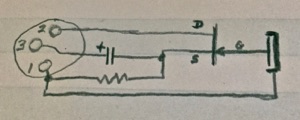“simple P48” Circuit with true condenser capsule

The Simplest “True Condenser” Circuit
Monday, January 18, 2021

Just how simple can a “true condenser” mic be? Can the “Simple P48” circuit used with small electret capsules work with externally polarized capsules? I decided to find out.
In Simple P48, the FET drain is at around 46V, the source (and therefore the gate) is around 6V less than the drain, at about 40V. That should be enough to polarize the capsule.
So, scrounging around in the scrap parts boxes, the makings of a test mic:
Does the “simple P48” Circuit work with “true condenser” capsules?

A broken one-dollar flashlight
A Neutrik male XLR plug
A 100K resistor
A 2uF capacitor
A 2SK596 JFET from a BM-800 mic
A capsule from an MXL 990 mic
Just going for proof-of-concept here. Stuff is tacked together, insulated with shrink tube and tape.




And yes, it does work. It’s a crappy mic to be honest, but it works. So the idea isn’t crazy, BUT . . .
What’s wrong with it? It’s noisy. About the same amount of noise as an unmodified BM-800. The FET is of dubious quality, was pulled from a $15 mic and sat in a plastic bag for a couple of years. The capsule is small, and not biased heavily. The capsule is not properly vented to the rear, causing a huge bass rise and lots of handling and plosive noise.
. . . . . . and then . . . . . .
Couple of days later. I happened to plug it into my TASCAM US-144mkII interface, and the noise is MUCH less than it was with the Focusrite Scarlett 2i2 gen3 interface. Hmmm... this bears looking into. Something’s going on I don’t understand, because the specs for the two interfaces don’t differ that much. But maybe this mic can be useful after all.
So I drilled a bunch more holes in the flashlight to vent the back of the capsule and stuffed it with damping material. It’s not bad with a quiet interface. Is it worth building something similar, maybe in a BM-800 body with a 34mm capsule, a known good FET, and so on? Personally, I wouldn’t. It’s not much harder to put together a mic with a Schoeps circuit which will make the most of the capsule. But this has to be the simplest circuit for a “true” condenser mic.



